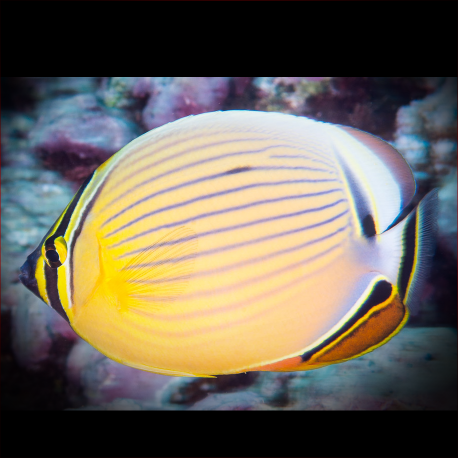More info
Datasheet
| Minimum Tank Size | 400 litres / 105.67 US gallons |
| Maximum Size | 20.0cm / 7.87inches |
| Reef Compatible | Not reef safe |
| Temperament | Might be aggressive |
| Temperature | 22.2°C / 71.96°F - 25.6°C / 78.08°F |
| Specific Gravity | 1.020-1.025 |
| Carbonate Hardness | 8-12 |
| pH | 8.1-8.4 |
General Description
Chaetodon lunula, commonly known as the Raccoon Butterflyfish, is a species belonging to the Chaetodontidae family. This fish species is recognized for its alluring patterns and vibrant colors. They are closely related to Angelfish but can be distinguished by the lack of spines on the sides of their heads. The Raccoon Butterflyfish is part of a group known for seeking soft corals primarily, such as Zoanthus, while others target various types of LPS corals. These fish are also known to feed on anemones, tubeworms, and bristleworms.
Aquarium Suitability
The Raccoon Butterflyfish is deemed suitable for aquariums with care. They require a tank size of at least 400 liters and must be provided with ample hiding spots, like live rocks. These fish are known to have a hardy nature and can coexist with multiple specimens of their own species if introduced simultaneously. It is crucial to establish a well-maintained aquarium with algae-rich rocks for grazing purposes.
Demands, Care, and Hardiness
These Butterflyfish are relatively hardy, making them suitable for aquarists with some experience. They thrive in aquariums with stable water conditions, including a pH range of 8.1-8.4, carbonate hardness (KH) of 8-12, and a temperature range of 22.2-25.6°C. They require regular feeding several times a day, especially when newly added to the tank, and appreciate a varied diet consisting of larger crustaceans, microalgae, and zooplankton.
Reef Suitability
The Raccoon Butterflyfish is not considered reef safe due to its tendency to nibble on anemones, clams, and sea urchins. They may pose a threat to other invertebrates within a reef environment.
Aquarium Setup
When setting up an aquarium for Raccoon Butterflyfish, it is essential to provide well-established live rocks with ample algae growth. The tank should have plenty of open space for swimming as these fish enjoy swimming freely in the water column. Additionally, creating hiding spots among rocks will help the fish feel secure in their environment.
Behaviour
While not excessively aggressive, the Raccoon Butterflyfish may display territorial behavior toward similar species. They generally ignore other fish species and can peacefully coexist with compatible tank mates. It is recommended to avoid keeping multiple similar Butterflyfish species together, unless they are a mated pair.
Feeding and Diet
Feeding the Raccoon Butterflyfish a varied diet is crucial for their health and wellbeing. They consume larger crustaceans, microalgae like spirulina, small crustaceans, and zooplankton. These fish have specific dietary requirements and may resist eating replacement foods; thus, offering a diet that mimics their natural habitat is essential.
Habitat and Distribution
The Raccoon Butterflyfish is found in the Indo-Pacific region, ranging from East Africa to the Hawaiian, Marquesan, and Ducie Islands. They can also be located in the Southeast Atlantic, specifically in East London, South Africa. This species inhabits coral reefs and rocky areas with abundant algal growth.

